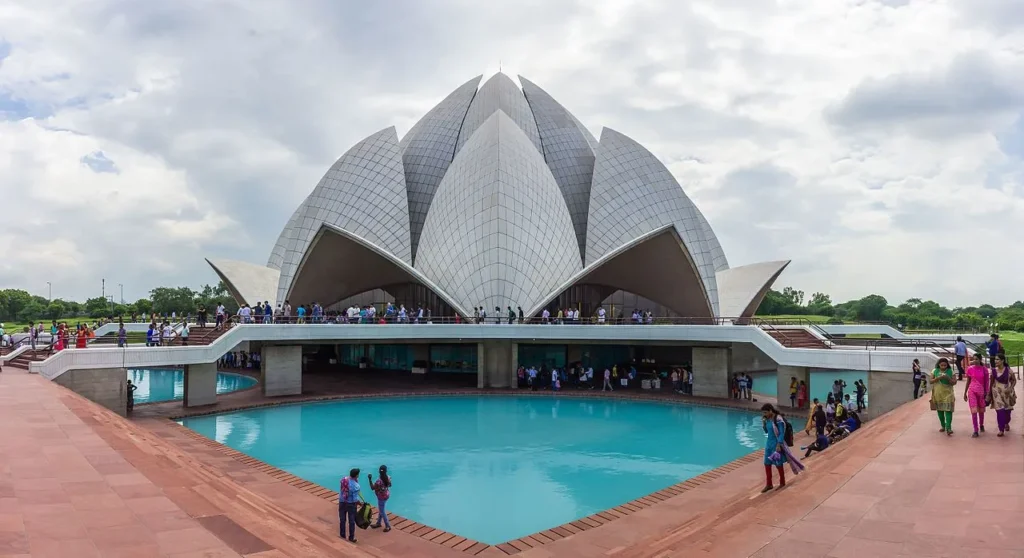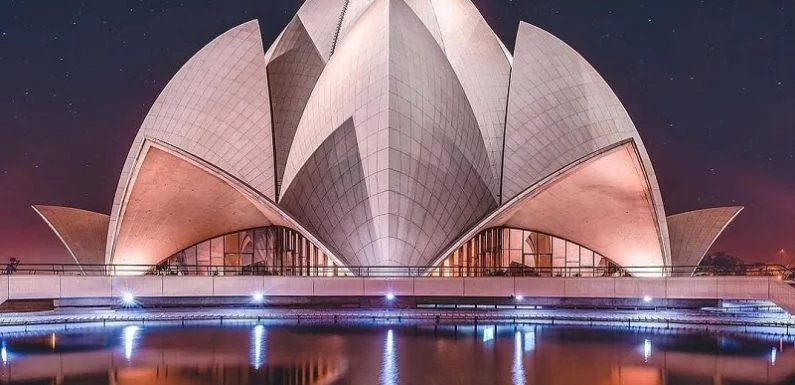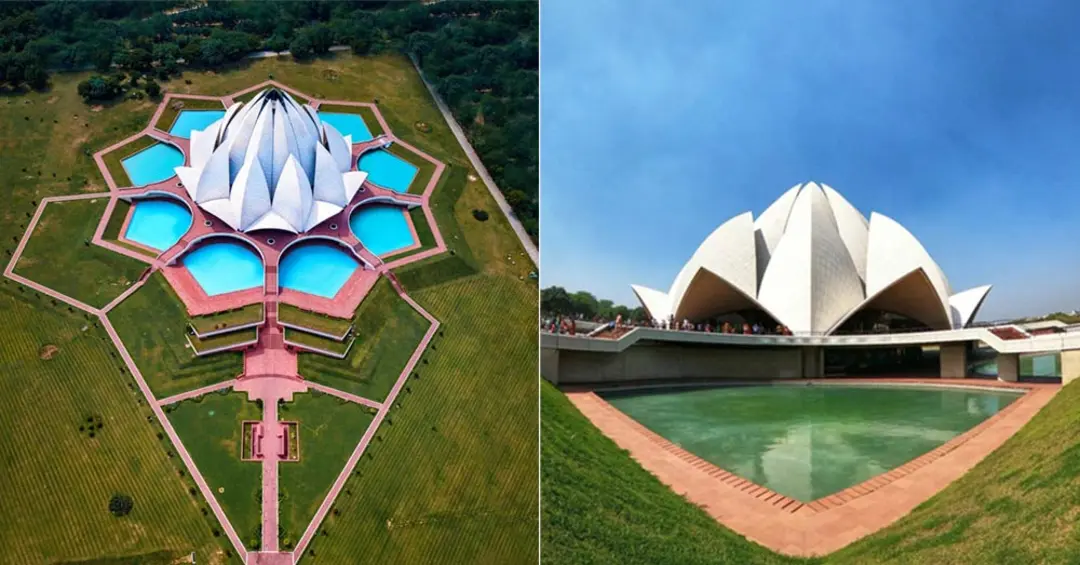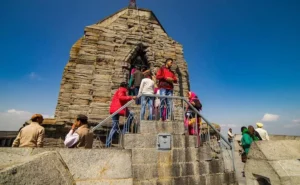Architecture
When you visit a historical site or sanctum in the national capital region, you cannot leave it without wondering about the genius behind its construction. The same feeling is induced in your mind while exploring Delhi ka Kamal Mandir. This is mainly because a lot of effort, expertise, and artistry is involved in the creation of this Baha’i place of workshop. Its architect, an Iranian national, Fariborz Sahba, planned and completed the construction in 1986. The architecture of Delhi’s lotus temple timings is unique in its own right. Interestingly, the importance of the number 9 can be observed in its architecture. As the Baha’i religion strongly believes in the mystical properties of this digit, the 26-acre property has nine pools and gardens surrounding the main shrine.
The petals of this temple are 27 free-standing marble constructions that are grouped in clusters of three to form nine perfect sides. Along with this, the temple has a roof made of glass and steel that allows natural daylight to enter inside the main building. It is because of the appearance of a blooming lotus flower that the Lotus Temple in Delhi has won a special award from the Institution of Structural Engineers calling it “a building so emulating the beauty of a flower and so striking in its visual impact”.
Timings and Tickets
When you are planning a vacation in the national capital, it is recommended to research on the internet early on. This will help you in organizing your trip in a proper way. Not only will you be able to visit the most popular places on your Delhi tour package but will also find the hidden treasures and hole-in-the-wall spots that can only be found after reading travel blogs and articles online.
Hence, it would be wise to take out some time from your busy schedule and do some solid research. While you are at it, do make sure to check out the opening and closing timings of the Lotus Temple in Delhi. During the winter months between October and March, Delhi ka Kamal Mandir is open between 9.30 to 5.30 pm while in the summer months from April to September, the timings are 9.30 am to 7 pm every day. You cannot enter inside the Lotus Temple in Delhi on Mondays as it is closed to the public.
There are no charges as the Baha’i community welcomes people from all walks of life without any entry fee. Besides the timing and tickets of Delhi’s Lotus Temple, you should note that photography can only be done after taking information from the authorities. This can be done by going to the Information Centre within the Lotus Temple, Delhi premises.

Must Read: Taj Mahal Timings, Story, History, & Facts
Historical Background
When we talk about the historical background of a tourist attraction, it is vital to understand the religious connotation attached to it. The Lotus Temple in Delhi is one of the main places of worship for the Baha’i Faith. Ardishir Rustampur of Hyderabad in Sindh, Pakistan was an extremely benevolent individual who donated his life savings for the development of the Lotus Temple in New Delhi. Although his donation was made in 1953. The international governing body of this religious community initiat the process of this temple’s construction only in 1976. The reason behind this delay is lost in history. The Lotus Temple in Delhi still stands to be an important place of worship for the Baha’i Faith. Tourists who like to pay their respects at religious places should choose to have an itinerary that allows them to visit all the popular temples in Delhi.
The Lotus Temple as a symbol of peace, purity and unity
A temple so divine that it attracts you to reaffirm your beliefs. Lotus Temple is a House of Worship built for everyone, from all backgrounds. It stands as a testament to undying humanity and unity among people. The soothing interiors are all about pure vibes and a calming atmosphere.
Additionally, there are no idols, photographs or statues of any specific religion or belief. Go, pray to the creator, meditate and learn about serving humankind, that’s all. There’s nothing beyond coming together as people to serve the universe!
The principle of worship here is simple! There are no religious ceremonies and reading of non-scriptural texts is permitt. No matter where you belong, you can pray, meditate and offer services in the name of your universal creator.
While communities chant different prayers of the Bahá’í Faith, you can chant any prayer. The purpose of the principle is to offer prayers to the creator of the universe. May it be anyone in your life, you can always visit the temple for self-reflection and connecting with god.
While you visit many places of worship dedicated to different religions, Lotus Temple is different. Interfaith harmony believes in the concept of live and let live. The temple plays a significant role in promoting the message with its magnificent structure. People from any religion, caste or creed can offer their services in the temple. National as well as international tourists, no matter their background, are allow to pray and meditate in this mesmerising structure.
It is because the Bahá’í Faith is all about one creator. It is also believ that the sole creator sent many other creators in the form of avatars. That’s exactly why you are free to worship, meditate, visit or be a part of activities in this House of Worship.
The Central Prayer Hall
The central prayer hall is one of the main attractions in the Lotus Temple. With a seating capacity of 1300 individuals, it is a place for meditating and worshipping the creator. A serene environment creates the perfect atmosphere for people of all kinds.
Awards and recognitions
In 1987, Fariborz Sahba received an award from the UK-based Institution of Structural Engineers for his excellence in religious art architecture.
1987, Fariborz Sahba again received an award for his excellence in religious art architecture from the Interfaith Forum on Religion, Art and Architecture, Affiliate of the American Institute of Architects, Washington, D.C.
The temple was conferr as the “Taj Mahal of the Twentieth Century” and receive the Paul Waterbury Special Citation. For Outdoor Lighting from the Illuminating Engineering Society of North America.
The American Concrete Institute’s Maharashtra-India Chapter presented the Temple with an award in 1989 for “Excellence in a Concrete Structure.”
The temple was recogniz as a notable historical accomplishment in the “Architecture” section of the Encyclopaedia Britannica, 1994 edition.
2000 witnessed the Architectural Society of China listed in “World Architecture 1900-2000: A Critical Mosaic, Volume Eight, South Asia” as one of the 100 canonical works of the 20th century.
In 2000, GlobArt Academy, based in Vienna, Austria, presented the GlobArt Academy 2000 award to the architect, Fariborz Sahba, for “the magnitude of the service of [this] Taj Mahal of the 20th century in promoting the unity and harmony of people of all nations, religions and social strata, to an extent unsurpassed by any other architectural monument worldwide.”
Apart from these awards, Lotus Temple has been a part of many publications and books out there. Baháʼí World Centre Library has more than 500 publications mentioning the architectural splendour of the Lotus Temple.

Best Time to Visit
In all honesty, planning a trip to Delhi is best done during the winter months of October to March. This is the time when the city is booming and so are its flowers! Experiencing ‘dilli ki sardi’ is one thing that you must have on your bucket list. As far as the Delhi ka Lotus Temple is concerned, you need not worry. It is open all year round so if you happen to be in town during the summer or monsoon season, then an expedition can be arrang without any hassles. Our personal recommendation would be to have serendipitous rendezvous at the Lotus Temple in Delhi in October when the weather is pleasant and walking around the entire premises will not break you into a sweat. As a popular picnic spot in Delhi, you can plan a late lunch with friends and family here.
Shopping Districts Nearby
The Lotus Temple has a perfect location in Delhi because it is accessible from all directions. Set in the village of Bahapur in Kalkaji, it can be easily reach via the Delhi Metro. The nearest metro station is Kalkaji Mandir located only 500 meters from this tourist spot. If you are in the mood to shop, then the most famous markets of the city are a stone’s throw away. Traditional suits, lehengas, and footwear can be bought. At dirt-cheap prices in Lajpat Nagar market situat only 4 km from the Kamal Mandir in Delhi. On the other hand, thrifty western wear, mobile accessories. And home decor are available at the Greater Kailash’s M Block market which is 4.6 km away.
Effects of Pollution on the Structure
Pollution is not only ruining human health but also the beauty of ionic structures. Lotus Temple is not new on the list! Just as the Taj Mahal is yellowing, the Greek marble of the Lotus Temple is majorly affect. It is believ that soon the marbles might turn grey due to emissions in the atmosphere.
Extreme traffic is the biggest cause of pollution. As per the study, it is observ that nearby slums indulge in burning rubber and plastic. This drastic move causes chemicals in the environment. Lastly, the Badarpur power plant is also responsible for immense fly ash and harmful gases impacting the magic of this temperature.
Be thrill to know about the advancements in the temple leading to an environmental balance. There is a developed system which harvests rainwater for gardening purposes. With an excellent sewage system, the temple can treat wastewater too. Vermicomposting initiatives ensure rich compost which is use as a fertiliser.
Map
Also Read: baps akshardham temple gandhinagar
Conclusion
Delhi’s Lotus Temple stands not only as a magnificent architectural marvel. But also as a symbol of unity, peace, and universal worship. Designed with meticulous attention to detail by architect Fariborz Sahba. Its unique structure embodies the spiritual beliefs of the Baha’i Faith. Incorporating the symbolism of the number nine and the lotus flower. Despite facing challenges from pollution, efforts to maintain its beauty and environmental sustainability are underway through innovative measures like rainwater harvesting and sewage treatment. Recognized globally through numerous awards and accolades. The Lotus Temple continues to draw visitors from around the world, offering a serene sanctuary for meditation, prayer, and reflection. As a testament to interfaith harmony and the pursuit of universal values. It serves as an enduring beacon of hope and inspiration for humanity.




